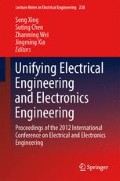Abstract
In MIMO-OFDM systems with multiple layers spatial multiplexing and high-order QAM, efficient MIMO detection is very significant for receiver design. Among current MIMO detection algorithms, K-Best is a prevailing algorithm with fixable balance between performance and complexity. However, the current K-Best and its varieties are not suitable for parallel programmable baseband architecture, such as DSP with VLIW, SIMD, or vector processing features. In this chapter, an improved K-Best detection algorithm is proposed, and an efficient soft-output algorithm is designed. Simulation results show that its performance is near to general K-Best with lowered time complexity, especially under high SNR. Using this algorithm, the system throughput can be increased in times.
Access this chapter
Tax calculation will be finalised at checkout
Purchases are for personal use only
References
Foschini GJ, Gans MJ (1998) On limits of wireless communications in a fading environment when using multiple antennas. Wirel Personal Commun 6(3):311–335
Telatar E (1999) Capacity of multi-antenna Gaussian channels. Eur Trans Telecomm 10(6):585–595
Ong EH, Kneckt J, Alanen O et al (2011) IEEE 802.11ac: enhancements for very high throughput WLANs. 2011 I.E. 22nd international symposium on personal indoor and mobile radio communications (PIMRC), pp 849–853
Ghosh A, Ratasuk R, Mondal B et al (2010) LTE-advanced: next-generation wireless broadband technology. IEEE Wirel Commun 17(3):10–22
Ahmadi S (2009) An overview of next-generation mobile WiMAX technology. IEEE Commun Mag 47(6):84–98
Golden GD, Foschini CJ, Valenzuela RA et al (1999) Detection algorithm and initial laboratory results using V-BLAST space-time communication architecture. Electron Lett 35(1):14–16
Haykin S, Sellathurai M, De Jong Y et al (2004) Turbo-MIMO for wireless communications. IEEE Commun Mag 42(10):48–53
Damen MO, El Gamal H, Caire G (2003) On maximum-likelihood detection and the search for the closest lattice point. IEEE Trans Inf Theory 49(10):2389–2402
Fincke U, Phost M (1985) Improved methods for calculating vectors of short length in a lattice, including a complexity analysis. Math Comput 44(4):463–471
David LM, Emesto Z, John RB, Gerhard F (2008) A framework for fixed complexity breadth-first MIMO detection. In: Proceedings of IEEE 10th international symposium on spread spectrum, Bologna, Italy, Aug, pp 129–132
Chan AM, Lee I (2002) A new reduced-complexity sphere decoder for multiple antenna systems. IEEE Int Conf Commun 1(7):460–464
Fasthuber R, Li M, Novo D, Raghavan P, Van der Perre L, Catthoor F (2009) Novel energy-efficient scalable soft-output SSFE MIMO detector architectures. ICSAMOS, pp 165–171
Shabany M, Vahdat BV (2010) A modified complex K-Best scheme for high-speed hard-output MIMO detectors. 2010 53rd IEEE international Midwest symposium on circuits and systems (MWSCAS), pp 845–848
Shabany M, Su K, Gulak PG (2008) A pipelined scalable high-throughput implementation of a near-ML K-Best complex lattice decoder. ICASSP: IEEE. ISBN 1-4244-1484-9, S. 3173–3176
Li Q, Wang Z (2006) An improved K-Best sphere decoding architecture for MIMO systems. Fortieth Asilomar conference on signals, systems and computers ACSSC’06, pp 2190–2194
Studer C, Bölcskei H (2010) Soft-input soft-output single tree-search sphere decoding. IEEE Trans Inf Theory 56(10):4827–4842
Kawai H et al (2005) Likelihood function for QRM-MLD soft-decision turbo decoding and its performance for OFCDM MIMO multiplexing in multipath fading channel. IEICE Trans Commun E88-B(1):47–56
Boutros JJ, Gresset N et al (2003) Soft-input soft-output lattice decoder for linear channels. GLOBECOM, pp 1583–1587
Acknowledgments
This work was supported by NSFC (61021001), National Basic Research Program of China (2012CB316002), National S&T Major Project (2010ZX03005-001-02), and China’s 863 Project (Research on the key technology of green networks).
Author information
Authors and Affiliations
Corresponding author
Editor information
Editors and Affiliations
Rights and permissions
Copyright information
© 2014 Springer Science+Business Media New York
About this paper
Cite this paper
Tan, C., Zhao, Y., Zhou, C., Li, Y. (2014). An Improved K-Best MIMO Detection Algorithm for Parallel Programmable Baseband Architecture. In: Xing, S., Chen, S., Wei, Z., Xia, J. (eds) Unifying Electrical Engineering and Electronics Engineering. Lecture Notes in Electrical Engineering, vol 238. Springer, New York, NY. https://doi.org/10.1007/978-1-4614-4981-2_170
Download citation
DOI: https://doi.org/10.1007/978-1-4614-4981-2_170
Published:
Publisher Name: Springer, New York, NY
Print ISBN: 978-1-4614-4980-5
Online ISBN: 978-1-4614-4981-2
eBook Packages: EngineeringEngineering (R0)

